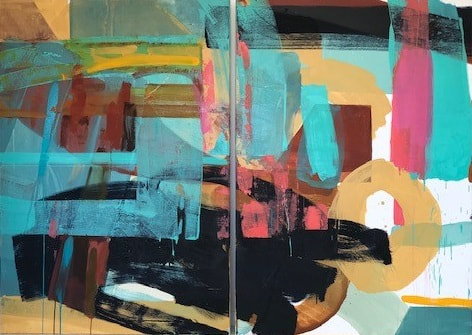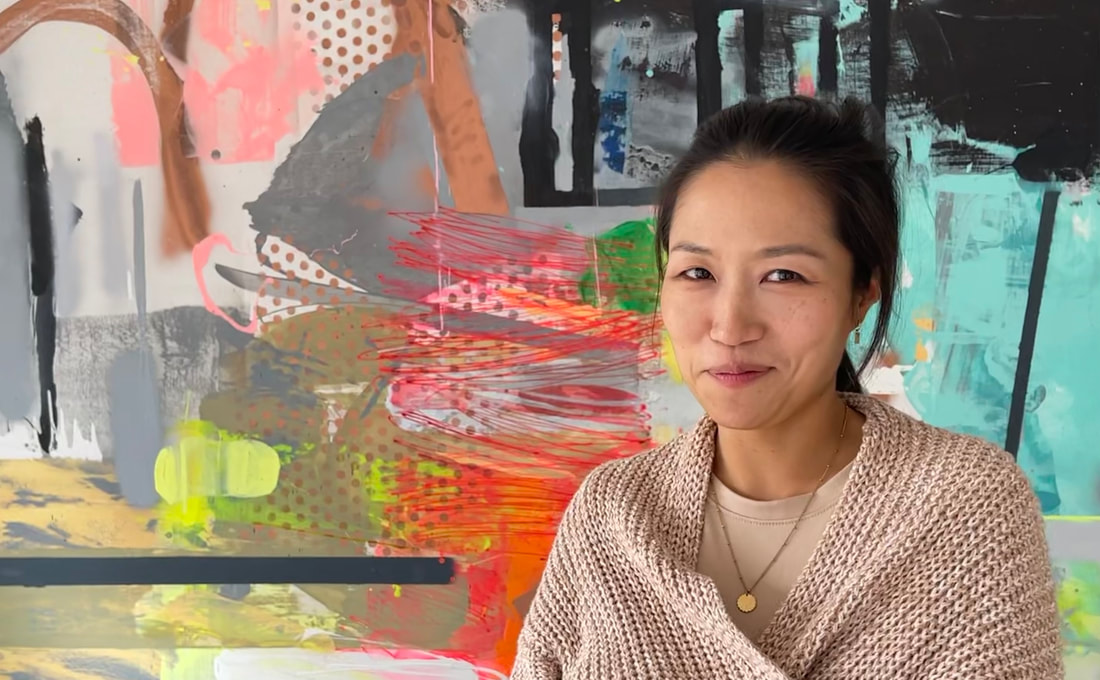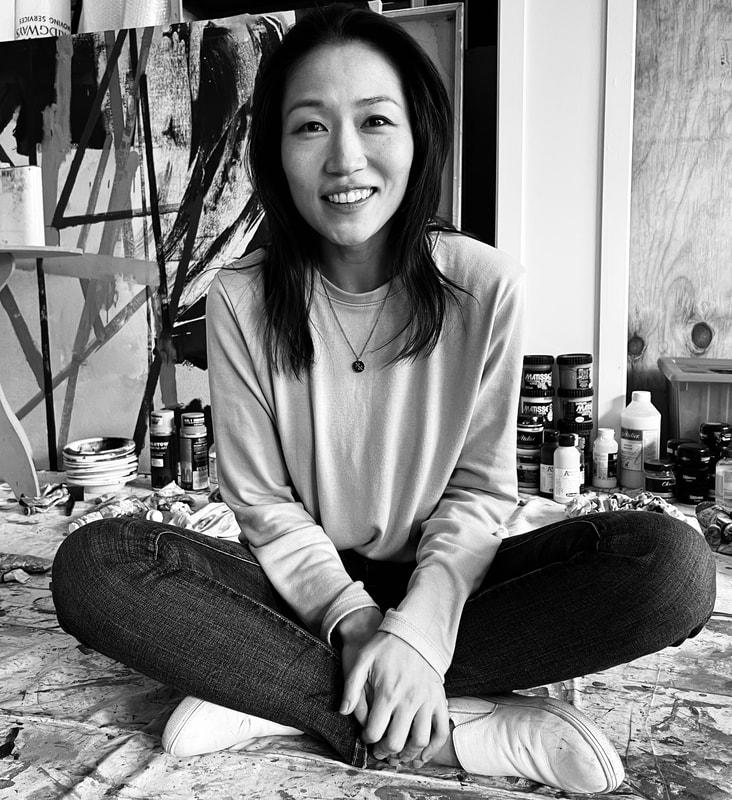Jee-Young Kim
ABOUT JEE-YOUNG KIM
|
Jee-Young Kim is a contemporary abstract artist based in Auckland. Originally from South Korea, Jee-Young immigrated to New Zealand in 1995 where she realized her love of art and sought to follow the path toward fulfilling her dream of becoming a professional artist.
Jee-Young studied at Elam School of Fine Arts at the University of Auckland before moving to New York on her own to embark on Post-Grad study (a Degree in Fine Arts) at the New York Studio School (of Drawing, Painting and Sculpture) - an experience that she thoroughly enjoyed as it allowed her to immerse herself completely in her art, to focus completely on the art itself. “You could spend all day drawing, painting, it was just ‘full-on art’, you could spend all day and night at the school - painting in groups on large drawings, or individually on something you wanted to develop alone. It was all about being immersed ‘in’ the art, as opposed to ‘studying around it’". |
At NYSS Jee-Young met Bill Jensen, a lecturer considered to be a great master, who became a wonderful influence and mentor. “He taught me what art should be, he told me that the painting will tell me when it is finished. I would show him a painting I thought to be near complete, and he would tell me it was a ‘good start’. I was always afraid to push a piece too far, to ruin it - but he would show me how to push it forward, not to be afraid but to embrace and take it further – it was this influence that truly showed me how to be an artist.”
New York challenged Jee-Young as a person and an artist and was the experience through which her art has evolved to what she is currently doing today. Bold and exciting as her work is, Jee-Young seeks not to convey an accurate depiction of any visual reality within her work, but instead to draw from her soul the very essence of her creativity. “I start with pink which I really like. I usually have pink in my paintings - it’s my favorite colour”, she explains with an endearing smile.
Upon her return from New York to New Zealand, Jee-Young joined Bath Street Gallery and enjoyed exhibiting with them for 11 years from 2003 – 2014 – in both solo and group shows. Her work continued to evolve, with solo shows selling out – “All apart from the one I want to keep – I keep one piece from every show, even though this usually ends up being the piece people want.”
New York challenged Jee-Young as a person and an artist and was the experience through which her art has evolved to what she is currently doing today. Bold and exciting as her work is, Jee-Young seeks not to convey an accurate depiction of any visual reality within her work, but instead to draw from her soul the very essence of her creativity. “I start with pink which I really like. I usually have pink in my paintings - it’s my favorite colour”, she explains with an endearing smile.
Upon her return from New York to New Zealand, Jee-Young joined Bath Street Gallery and enjoyed exhibiting with them for 11 years from 2003 – 2014 – in both solo and group shows. Her work continued to evolve, with solo shows selling out – “All apart from the one I want to keep – I keep one piece from every show, even though this usually ends up being the piece people want.”
Jee-Young’s pieces are often big – diptych, triptych or large, vibrant works that command a room and the attention of all in it. “I love to work at a distance, to see what is working well – if every colour is working together, to assess the structure, add colour or leave something out – the subtle detail that either adds to or subtracts from the piece. Everything, every detail has to have a purpose. Sometimes I just have to add one more thing to finish it.”
Jee-Young moved to Sydney with her husband in 2007 and whilst there, continued showing with Bath Street Gallery and painting commissioned pieces for her Sydney collectors. As her family grew she moved away from her art, but her return to New Zealand sees a return to it and we are extremely excited by her work and to have her join Quay Gallery.
Jee-Young moved to Sydney with her husband in 2007 and whilst there, continued showing with Bath Street Gallery and painting commissioned pieces for her Sydney collectors. As her family grew she moved away from her art, but her return to New Zealand sees a return to it and we are extremely excited by her work and to have her join Quay Gallery.
Artist Statement:
"Thought cannot be thought unless it is directed towards a conclusion, whether in action or judgement. We try in ordinary speech and thought, to keep the distinction between thought and action, but thought itself is an introduction to action. So the primary question to me about work of art is what they are, rather than what they mean.
I am not trying to either depict or to express, I am working with the moment, working to see what happens, but not accidently. I paint until I achieve an aesthetic balance of colour, mark and form, and when I get what I aimed for, I stop. Whatever we deal with - canvas, paper or wall, we deal with a stage where something is happening. What happens is a fact, a coincidence, an outcome, a surprise and an action.
Painting has become a way for me to contribute a new visual language, one that’s fresh and new yet stimulates and enhances life. I often begin with the lines and tones, making people see things, a few brush strokes, a touch of colour, leaving all my process of moving hand to achieve the creative ‘moment’ in terms of ‘an abstract rhythm’.
Colour has always been the most important issue because it gives the full impression for a picture and people see the surface of the canvas as ‘colour’. When people talk about colour, they have to use words. This can be difficult because like music, colour isn’t something that language can easily capture. It’s simpler to demonstrate what colour does than to describe it. There are no hierarchies, only random colour events, and all colours become equal. Painting is to be interesting, not boring, breaking the habit, style is important, thinking is the last thing to do."
"Thought cannot be thought unless it is directed towards a conclusion, whether in action or judgement. We try in ordinary speech and thought, to keep the distinction between thought and action, but thought itself is an introduction to action. So the primary question to me about work of art is what they are, rather than what they mean.
I am not trying to either depict or to express, I am working with the moment, working to see what happens, but not accidently. I paint until I achieve an aesthetic balance of colour, mark and form, and when I get what I aimed for, I stop. Whatever we deal with - canvas, paper or wall, we deal with a stage where something is happening. What happens is a fact, a coincidence, an outcome, a surprise and an action.
Painting has become a way for me to contribute a new visual language, one that’s fresh and new yet stimulates and enhances life. I often begin with the lines and tones, making people see things, a few brush strokes, a touch of colour, leaving all my process of moving hand to achieve the creative ‘moment’ in terms of ‘an abstract rhythm’.
Colour has always been the most important issue because it gives the full impression for a picture and people see the surface of the canvas as ‘colour’. When people talk about colour, they have to use words. This can be difficult because like music, colour isn’t something that language can easily capture. It’s simpler to demonstrate what colour does than to describe it. There are no hierarchies, only random colour events, and all colours become equal. Painting is to be interesting, not boring, breaking the habit, style is important, thinking is the last thing to do."














